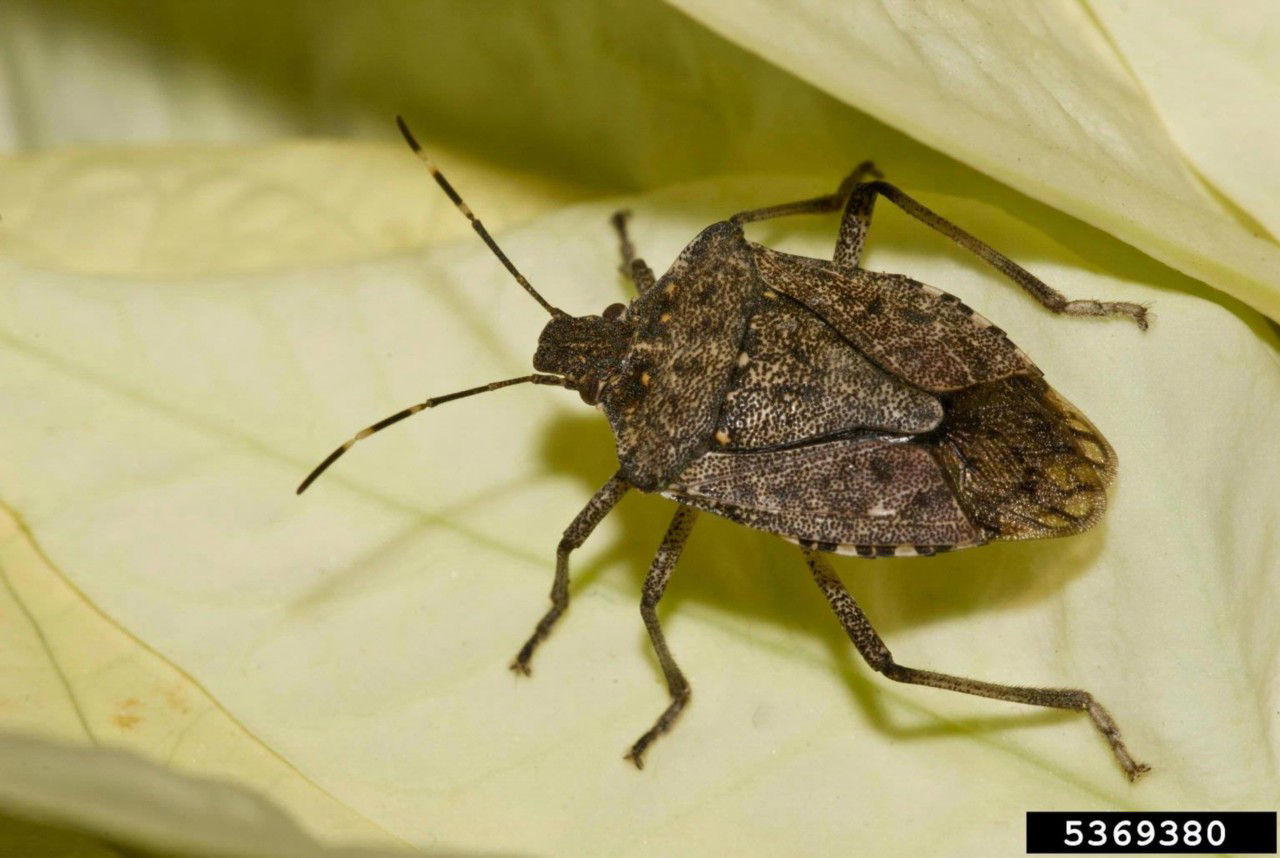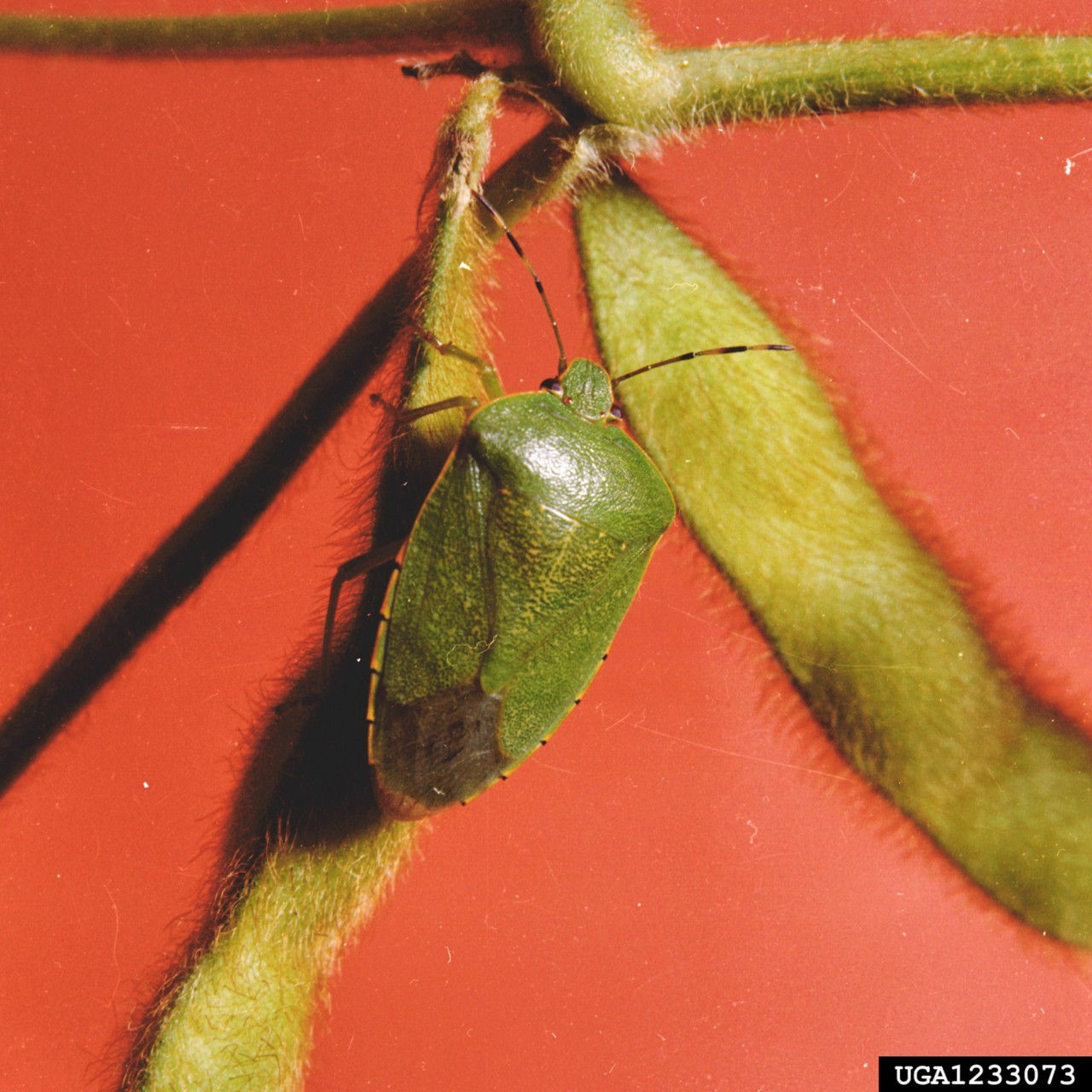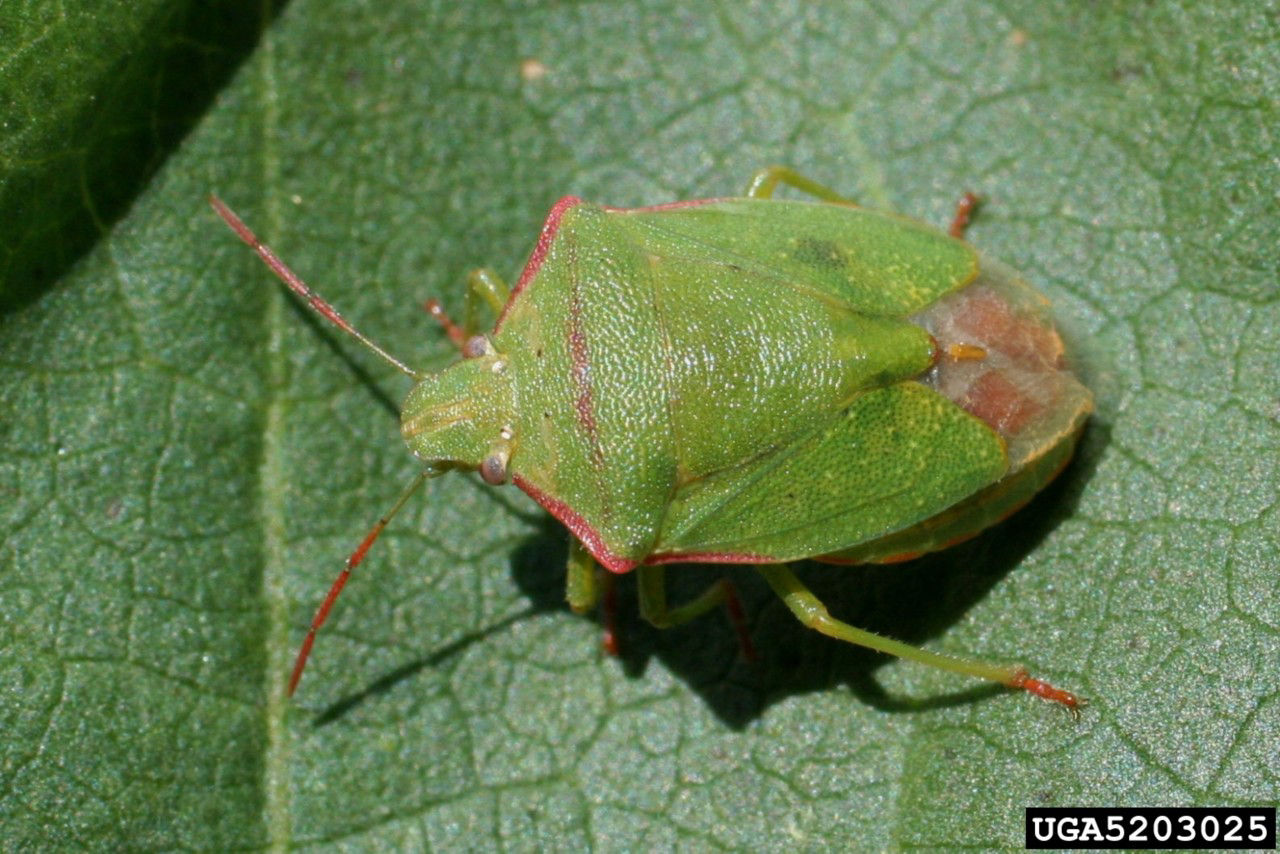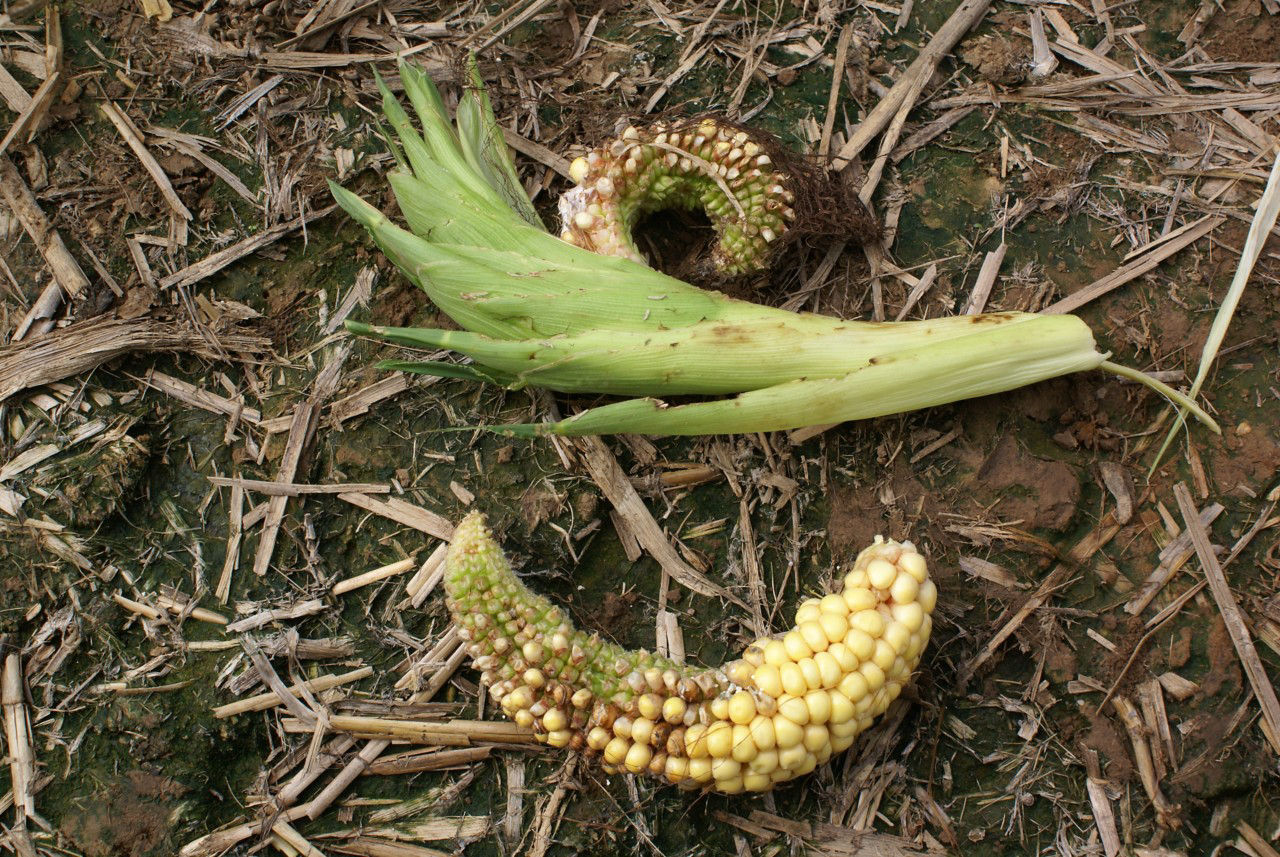5 MIN READ
Common Stink Bugs in Corn
April 22, 2023
Stink bug or shield bug injury in corn has been increasing the past several years. Usually, only a small number of fields exhibit economic injury. The damage is usually widespread within the field; however, the damage can be devasting in infested areas. When feeding, the insects inject tissue destructive saliva into the plant through their stylet, a piercing-sucking mouthpart. While the stylet itself can cause mechanical injury, the material pumped into the plant in combination with the mechanical damage is thought to cause the injury symptomology.
Species and Biology
There are several stink bug species that may feed on corn; however, the brown stink bug (Figure 1), southern green stink bug, and one-spotted stink bug are the most common in the southeastern United States. In the Central Plains, in addition to the previously mentioned species, the green stink bug (Figure 2) and red shouldered stink bug (Figure 3) have also been reported to damage corn and soybean. Recently, a new invasive species, brown marmorated stink bug (Figure 4), is also becoming a concern throughout much of the United States.

Figure 1. Brown stink bug. Picture courtesy of and used with the permission of Herb Pilcher, USDA Agricultural Research Service, Bugwood.org.

Figure 2. Green stink bug. Picture courtesy of and used with the permission of Clemson University - USDA Cooperative Extension Slide Series, Bugwood.org.

Figure 3. Red shouldered stink bug. Picture courtesy of and used with the permission of Russ Ottens, University of Georgia, Bugwood.org.

Figure 4. Brown marmorated stink bug. Picture courtesy of and used with the permission of Susan Ellis, Bugwood.org.
The biology and injury symptoms of the different stink bug species are very similar. The adults of the brown marmorated stink bug overwinter in protected locations. The females deposit barrel-shaped eggs in a mass of 15 to 20 on host plant leaves (Figure 5). The eggs hatch in mass and in some cases, the female guards both the egg mass and developing nymphs. In some cases, the nymphs do not look anything like the adult in coloration (Figure 6). Feeding by both the adults and nymphs can result in injury.1

Figure 5. Green stink bug egg mass. Picture courtesy of and used with the permission of Herb Pilcher, USDA Agricultural Research Service, Bugwood.org.

Figure 6. Green stink bug nymphs. Picture courtesy of and used with the permission of Herb Pilcher, USDA Agricultural Research Service, Bugwood.org.
Stink Bug Injury and Plant Damage
Corn produced in no-till systems, particularly fields bordered by woods, appears to be at a higher risk for potential infestation and injury. While conventional-tilled fields can experience stink bug injury, the injury is usually less severe and limited to the border rows. In the southeastern United States, surveys documented that a soybean-wheat-corn rotation is conducive to an increased risk of stink bug injury in corn.
Stink bugs can cause damage to corn at three main stages: seedling, early and late vegetative, and after grain fill. Feeding injury to seedlings is usually at the soil line and can result in plant death. Injury to later vegetative stages results in a row of irregular oblong-shaped holes in the leaves with the fringe being yellow.2 This can sometimes be confused with billbug injury; however, billbug injury doesn’t have the yellow fringe around the hole margins. An additional injury symptom in the vegetative stage is excessive tillering. Feeding during the early reproductive stages on the developing ear can result in “banana ears” (Figure 7), while less severe injury can result in missing or deformed kernels. Feeding injury can extend into the late milk or early dent stage as well. The damage includes deformed kernels, some with obvious holes because of feeding.3,4

Figure 7. Banana shaped ears resulting from stink bug feeding.
Scouting Strategies and Treatment Guidelines
Scouting during the first two weeks after emergence is the most effective way to help prevent stink bug damage. The base of the plant should be examined as adults usually feed about one inch above the soil line. Field margins should be a focus, particularly in those fields which have a history of stink bug injury. Pick at least 5 random field places and look for adults or injury on 20 consecutive plants at each location (total of 100 plants). For injury to later growth stages, focus on field margins and pay particular attention to the ear nodes as the stink bugs tend to concentrate in the ear zone area. As with scouting seedling plants, choose 5 random locations and count the number of stink bugs on 20 consecutive plants. If stink bugs are found on the edge of the field, walk into the field at least 100 feet to determine if the infestation has spread inward.
Treatment Guidelines
Treatment guidelines can vary from state to state; therefore, your local extension service should be consulted for local recommendations. A working treatment guideline for the Midwest is one stink bug per four plants (25% infested plants) prior to pollination, and one stink bug per two plants (50% infested plants) after pollination up to early dough stage.4 In the southeastern United States, the thresholds are based on a 100-plant sample; if a treatment decision cannot be made, continue to sample until a confident decision can be made (Table 1).3,5,6
Table 1. Stink bug treatment guidelines for corn in the southeastern United States.*

Sources:
1Koch, R. L., Pezzini, D. T., Michel, A. P., and Hunt, T. E. 2017. Identification, biology, impacts, and management of stink bugs (Hemiptera: Heteroptera: Pentatomidae) of soybean and corn in the Midwestern United States. Journal of Integrated Pest Management Volume. 8:1–14. https://academic.oup.com/jipm/article/8/1/11/3745633/.
2Tooker, J. 2022. Stink bug damage to vegetative corn plants. PennState Extension. The Pennsylvania State University. https://extension.psu.edu/stink-bug-damage-to-vegetative-corn-plants/.
3Bessin, R. 2019. Stink bug damage to corn. ENTFACT-305. Cooperative Extension Service. University of Kentucky. https://entomology.ca.uky.edu/ef305/.
4Hunt, T., Wright, B., and Jarvi, K. 2015. Stink bugs reported in corn and soybean. CROPWATCH. Institute of Agriculture and Natural Resources. University of Nebraska-Lincoln. https://cropwatch.unl.edu/stink-bugs-reported-corn-and-soybeans/.
5Reisig, D. 2019. Scout before spraying stink bugs in corn. North Carolina State University Extension. https://corn.ces.ncsu.edu/2019/06/scout-before-spraying-stink-bugs-in-corn/.
6Bryant, T. 2020. Brown stink bug as a pest of corn in the southeastern United States. LGP 1082. Land-Grant Press® by Clemson® Extension https://lgpress.clemson.edu/publication/brown-stink-bug-as-a-pest-of-corn-in-the-southeastern-united-states/.
7Reisig, D. and Heiniger, R. 2023. Stink bug management in corn. North Carolina State University Extension. https://corn.ces.ncsu.edu/corn-insect-management/scouting-and-thresholds/stink-bug-management-in-corn/.
Websites verified 3/21/23 1215_121997